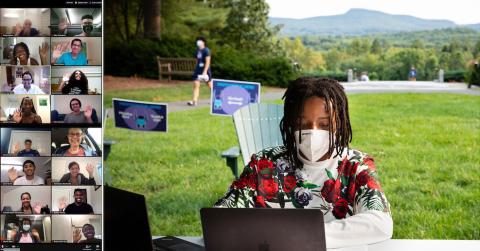Notes from the Amherst Classroom
Academic Technology Services (ATS) is pleased to present this snapshot of how five Amherst College faculty approached the challenge of teaching to both in-person and remote students during the Fall of 2020.
Jump to: What is a HyFlex course? ♦ Ryan Alvarado ♦ Lloyd Barba ♦ Nicola Courtright ♦ Amalia Culiuc ♦ Catherine Infante ♦ Challenges and Recommendations ♦ Related Resources ♦ Help, Advice, & Support

Kiiren Jackson ’24 attends “Introduction to Black Studies” via Zoom from a tent on the Main Quad, near Memorial Hill. This course was taught by Professor Solsiree del Moral (shown in Zoom class column one, box three).
Whether teaching in-person or online, faculty must continually revise and improve their courses from semester to semester. It can be hard to know how well a new approach will work until it is tried, but that process of continued experimentation is part of what makes teaching enjoyable.
This year, however, the need for pedagogical and technological experimentation was taken to a new level. One popular approach that emerged was HyFlex - a combination of in-person and online content delivery that provides students multiple access options to participate in a course, depending on their needs. While this approach can provide flexibility for students, it also raises new challenges for faculty as they design their courses.
While the pedagogical and technological aspects of teaching are entwined - now, more than ever - the following snapshots focus on a selection of creative technological approaches that Amherst College faculty tried out in the Fall 2020 semester, along with outcomes of their experiments. These solutions provide a solid foundation for continued innovation in course development.
Be sure to see our notes on the challenges and recommendations of the HyFlex modality, as well as our Help and Resources sections for connecting with our partners in the Center for Teaching and Learning and IT/Multimedia Services.
What is a HyFlex Course?
With the objective of providing students with an equitable learning experience, HyFlex combines Hybrid and Flexible learning modalities. The Hybrid aspect links face-to-face synchronous learning with online asynchronous learning. The Flexible aspect gives students agency in how they participate in the course and have the option of changing their learning modalities from session to session.
According to Beatty (2019) who conceptualized the HyFlex model, four values have guided the HyFlex design effort since its beginning in 2006. They are: learner choice, equivalency, reusability, and accessibility.
For the purposes of this article, we are narrowing down the scope of HyFlex to mean a specific scenario at Amherst College in fall 2020 where the faculty member was delivering the course in parallel to a group of students that were in-class on campus, and other students that were engaging with the class online via zoom.
Beatty, B. J., ed. (2019). Hybrid-Flexible course design: Implementing student-directed hybrid classes (1st ed.). EdTech Books. Retrieved from https://edtechbooks.org/hyflex.
In this excerpt from President Biddy Martin's December 2020 video message, students and faculty reflect on the challenges and successes they experienced teaching and learning in Fall 2020.
Image

Ryan Alvarado

MATHEMATICS AND STATISTICS
Course: MATH-105 Calculus with Algebra
Enrollment: 13 students, 11 in-person and 2 remote
Professor Alvarado chose to physically lecture while in the classroom but also used Zoom on his laptop to engage with remote students during class. He lectured using a whiteboard app on his tablet that was both projected in the classroom and shared in the Zoom meeting for the remote students. Zoom sessions were recorded on the laptop so that the shared tablet screen and audio were captured. In addition, Professor Alvarado created a shared Google Drive folder to share lecture recordings and Gradescope, as well as to collect and grade student’s problem sets and exams. He also utilized Dropbox’s request feature for larger projects.
Image

Lloyd Barba

Latinx and Latin American Studies, Religion
Class: RELI-134 Religious Traditions in America and RELI-234 The Sanctuary Movement
Enrollment: Approximately 12 students per class, approximately 50% remote
Professor Barba began teaching both his courses in the tents but eventually transitioned to classrooms by the end of the semester due to the cold weather and outdoor noise (which was an issue for one class taught during the noon lunch hour).
For lectures, he used Zoom on his iPhone as the primary method of engaging with the remote students, and at the same time used Zoom on his laptop for sharing his slides and recording the sessions. His phone sat on a ring light tripod and he used a wireless microphone so he could roam about the room. For smaller discussion sections, he used his laptop and the built-in mic/speaker for the whole group. In-person students also logged into Zoom on their laptops, but stayed muted and either used headphones or turned off their volume to avoid feedback.
Professor Barba recorded all lectures and made them available in Moodle, and also shared the day’s slides shortly before the start of class, so remote students could follow along. Building a sense of community was a primary goal driving Professor Barba’s approach, especially in The Sanctuary Movement, “as our class ethic was grounded in producing knowledge ‘en conjunto’ (together).”
Image

Nicola Courtright

Architectural Studies, Art and the History of Art, European Studies
Class: ARHA-135 Renaissance to Revolution: Early Modern European Art and Architecture
Enrollment: 20 students, approximately 16 in person and 4 remote
Professor Courtright taught this course remotely, but it was important that students be given the opportunity to view enlarged images of artwork on a high-definition projector, and to be able to discuss the material with each other in person. With the assistance of IT staff and a dedicated TA, most of her students assembled in a classroom while Professor Courtright presented to them over Zoom, with the Zoom video and her presentation showing on the large screen. Remote students simply joined the same Zoom meeting.
Having all students participate via Zoom, whether in-person or remote, allowed all students to immediately ask and answer questions through the same channel. This also made it possible for Professor Courtright to record the classes for those that needed to join asynchronously (or who wanted to revisit the class after attending). One difference between the groups, however, was that in-person students would step out of Zoom to meet for small group discussions, while the remote students would continue to talk together in Zoom.
Image

Amalia Culiuc

Mathematics and statistics
Class: FYSE-103 Fake News
Enrollment: 15 students, approximately 50% remote
Professor Culiuc’s class began the semester meeting remotely via Zoom, but in October she introduced the option for students to attend certain class meetings in person. During these meetings, some students were still remote, while others came to class. All students signed in to the Zoom meeting, but the in-person students kept themselves muted and their volume turned down. The class used Professor Culiuc’s laptop to hear and be heard, using the laptop speakers and an external microphone (which worked fine as long as students spoke clearly).
Professor Culiuc used Moodle extensively for organizing the class. Each day’s schedule listed action items to be completed before class (readings, assignments due, questions to be answered in the discussion forum) and after (such as watching the video if not attending the lecture). Over the course of the semester, a handful of students shifted to asynchronous participation due to time zone challenges. These students were required to submit additional posts in discussion forums and/or to answer questions from the synchronous discussion in writing.
Using a HyFlex approach gave Professor Culiuc the opportunity to set expectations and address informal feedback, while also building a sense of community. It also allowed for flexibility as the needs of students shifted throughout the semester. Moodle provided a centralized location for students to access the course, regardless of changes to how they interacted from class to class. According to Professor Culiuc, “as the semester progressed, students became more articulate both in their speaking and in writing, and their final evaluations were unanimously and overwhelmingly positive - I couldn't ask for anything more from this Fall.”
Image

Catherine Infante

European Studies, Spanish, Latinx and Latin American Studies
Class: SPAN-305 Short Stories from the Hispanic World
Enrollment: 18 students, approximately 50% remote
Professor Infante designed a class meeting schedule with a goal of building community among both in-person and remote students. This class was scheduled to meet twice a week for 80 minutes. Every other week, the whole class met for 80 minutes via Zoom. In the alternating classes, Professor Infante met in a classroom with the on-campus students for 40 minutes, and then met via Zoom with the remote students for 40 minutes. In the remaining class time, students worked on asynchronous activities.
By splitting the class up in this way, Professor Infante was able to “focus intensely on the 9 students in person or the 9 students online and they all got more time to talk (without having to worry about the technical difficulties of combining both at the same time).” An unexpected benefit of this approach was that students attending remotely felt less fatigued due to the reduced synchronous time commitment required. For the in-person students, they expressed gratitude for the opportunity to attend an in-person class. In some cases, students were moving back and forth between these two options, Professor Infante is glad to have organized the course in this way, to provide them with that flexibility.
Challenges and Recommendations
Running a class in a HyFlex modality presents unique challenges and limitations. Common themes observed by Amherst faculty were:
- There was generally a prolonged period of experimentation at the beginning of the semester before each faculty member found the particular strategy and equipment that worked for them. Working closely with IT and engaging a TA can make the process go more smoothly.
- Some strategies made it difficult for the in-person students to communicate directly with the remote students. In these cases faculty found it was effective to incorporate more asynchronous activities that let the in-person and remote students work together.
- Students’ mode of participation often changed over the course of the semester, with students switching from in-person to remote attendance, or requiring asynchronous participation options. Enormous flexibility was required of the faculty from week to week.
Related Resources
Amherst College
- Resources and Strategies for Teaching & Learning During COVID-19 — More strategies for teaching both in-person and remote students, including alternative methodologies. (Academic Technology Services and Center for Teaching and Learning)
- HyFlex Overview and Resources (Center for Teaching and Learning)
- Flexible and Resilient Teaching (Center for Teaching and Learning)
- Flexible Teaching Models (Center for Teaching and Learning)
Other
- Beatty, B. J., ed. (2019). Hybrid-Flexible course design: Implementing student-directed hybrid classes (1st ed.). EdTech Books. Retrieved from https://edtechbooks.org/hyflex.
- Hybrid / HyFlex teaching and Learning - Columbia University, Center for Teaching and Learning page
Help, Advice, & Support
- Within IT, support for these strategies is provided by IT Support Services, Multimedia Services, and Academic Technology Services. Please email askIT@amherst.edu to contact any or all of these departments.
- For pedagogical support and consultations, please contact the Center for Teaching and Learning.
Acknowledgements: Our thanks to the Amherst College Communications department for providing the image and video.
Published Spring 2021 by Academic Technology Services